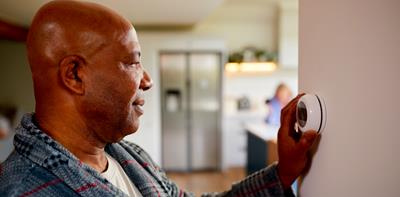
It’s not pleasant living in a damp house. As well as the musty smell and ugly damp or mouldy patches, it can lead to health problems, such as allergies or asthma[1] and much more serious illness if it's not addressed.
Damp can also lead to higher energy bills. The more humid the air is in your house, the more energy it takes to warm it because it is also warming the water in the air[2]. And, fixing damp – and the damage it causes – can get expensive too.
So, the sooner you can spot signs of damp and condensation and take action, the easier and cheaper it should be to get rid of. If damp is not dealt with properly, it can also cause damage to your home and contents – and this is not usually covered by home insurance.
What are the signs of damp?
A family of four will create an average of more than 100 pints of moisture each week, according to Energy Saving Trust[3]. This comes from sources including cooking, clothes drying, bathing and even breathing. And if there’s nowhere for this damp to escape, then it will build up on surfaces in your home.
It can be fairly obvious if you have a problem with moisture in your home. Some signs to look out for include:
- Wet patches on your walls
- Peeling wallpaper and flaking plaster
- Damp and musty smells
- Rotting skirting boards
- Mould on walls, floors or ceilings
If dampness is just at the bottom of a wall, the issue is likely to be ‘rising damp’. This is where water moves up through the house due to damage to a layer of waterproof material known as a damp-proof course.
Dealing with damp without spending a fortune
There are plenty of steps you can take to tackle or prevent damp and condensation in your home.
For a start, it can help to keep indoor temperatures at least 18°C. If you have rooms where the heating is turned off over the winter, then they may be especially prone to damp problems.
At a time of high heating costs, this can be expensive. But there are also some lower cost methods to deal with damp.
These include:
- On dry days, open some windows to ventilate your home. But keep windows closed on wet days as damp air may increase indoor humidity.
- When cooking, keep lids on your pots and pans, with the door to the kitchen closed, the extractor fan on and kitchen windows open.
- When having a bath or shower, keep the door to the bathroom closed, the window open and extractor fan on (if you have one).
- Keep curtains open in the day - to capture heat from the sun - and close them before dusk.
- Wipe moisture from windows to avoid it raising humidity levels and collecting on the frame and causing rot.
- Keep furniture away from outside walls to allow air to circulate.
- Try to dry your clothes outside, whenever possible. If you have to dry your clothes on a rack inside, do so in a well-ventilated room and close the doors.
- Try not to use a portable gas heater. They create high levels of humidity and are expensive to run.
- Increase ventilation by avoiding blocking wall vents and keeping window vents open if you have them.
- So-called ‘penetrating damp’ (when water comes in through an external wall) can be caused by water leaking from broken or blocked gutters and downpipes, so make sure you check your gutters regularly.
In your battle against damp and moisture, you may also need to invest in some other measures, such as:
- Buying a dehumidifier, to draw moisture out of the air: the best modern models are energy efficient, but do your homework and find one that won’t cost a fortune to run. For example, Expert Reviews recommends Meaco’s MeacoDry Arete One 20L, which costs around 6p per hour to run, based on an electricity rate of 28.3p per kWh.
- Add window vents (also known as ‘trickle vents’) to the tops of window frames.
- Invest in thermal or lined curtains.
- Build air bricks into outside walls.
- Install air vents to internal walls and any sealed chimneys to promote air flow and improve ventilation.
- Fit roof ventilation tiles to allow air to circulate through your loft.
- Install extractor fans in your bathroom and kitchen, if you don’t already have them.
If the problem is rising damp, then it is advisable to talk to a professional before taking any action.
Either way, the most important thing is to take action sooner rather than later to do away with the damp!
For more tips on how to stay happy and safe in your home, go to Solved.
[1] https://www.nhs.uk/common-health-questions/lifestyle/can-damp-and-mould-affect-my-health
[2] https://www.oxford.gov.uk/info/20271/guidance_for_private_tenants/1129/preventing_damp_and_mould

